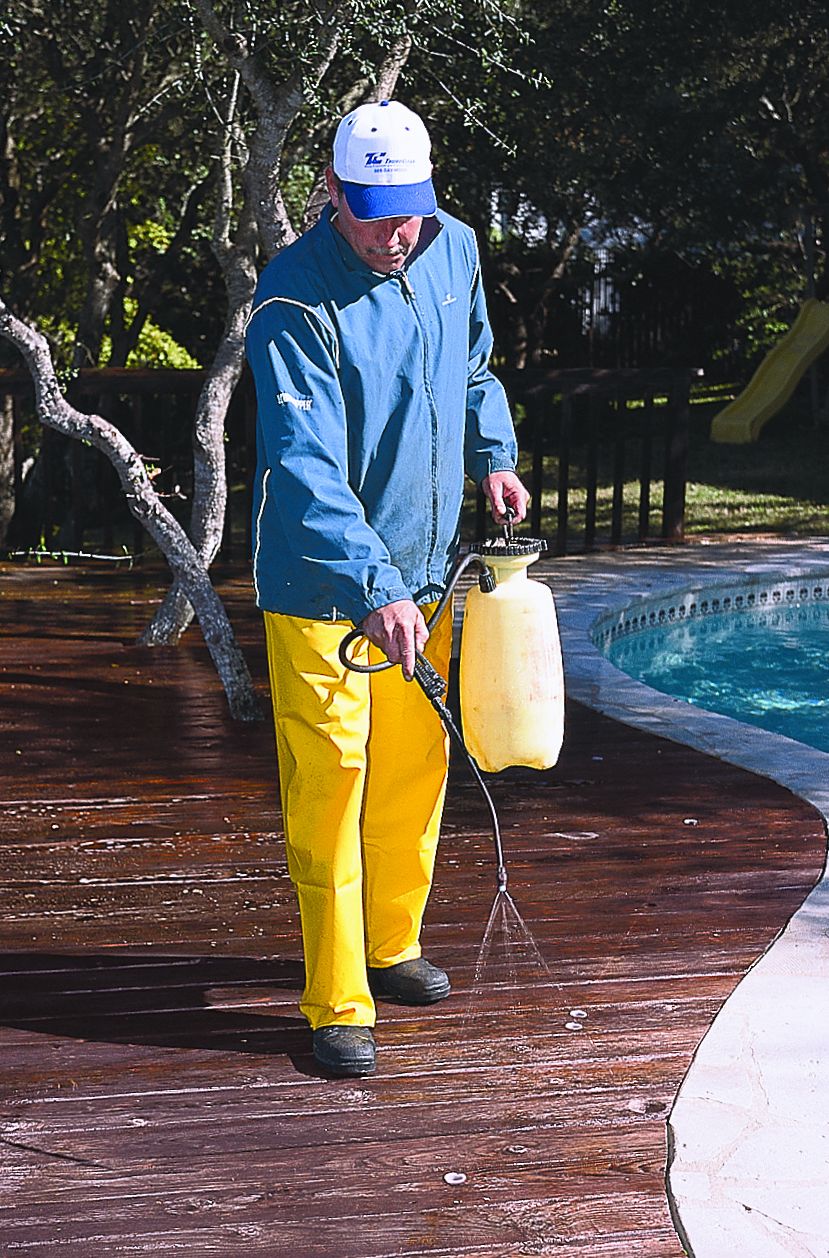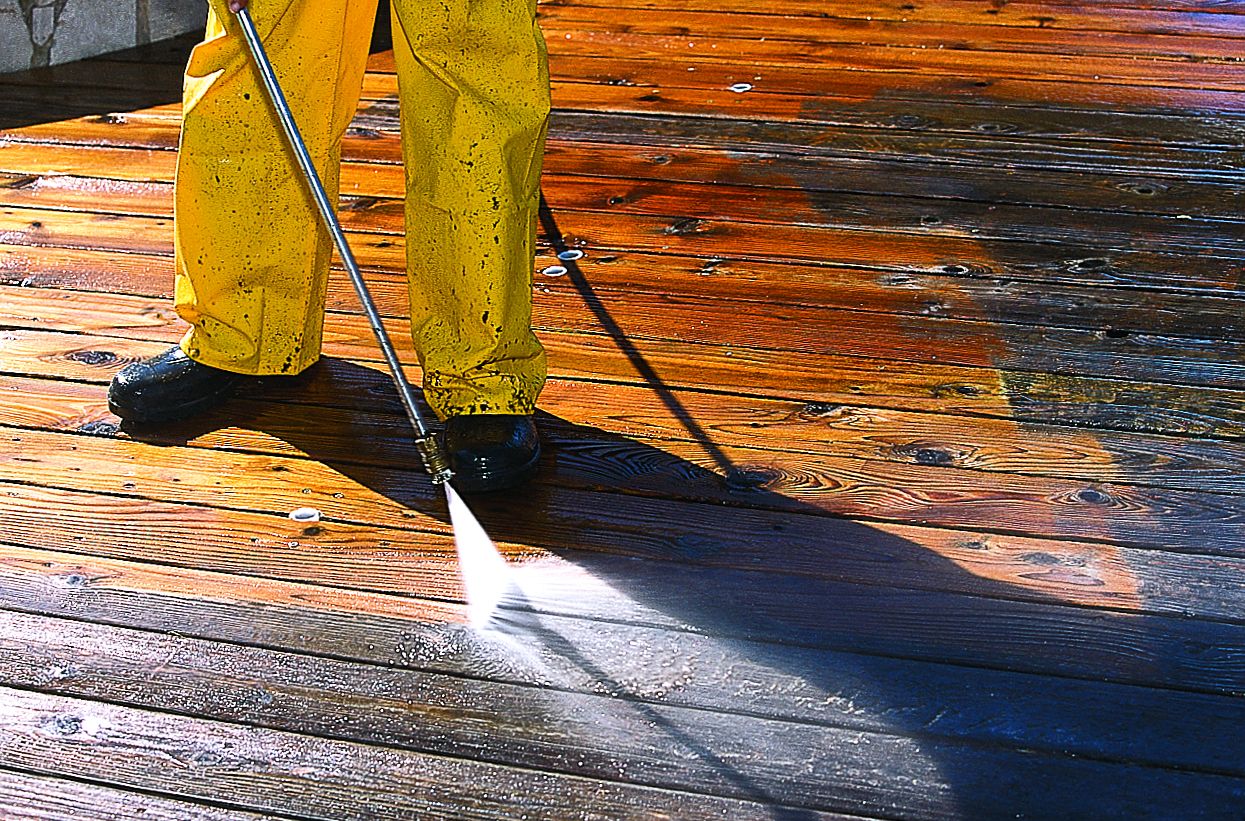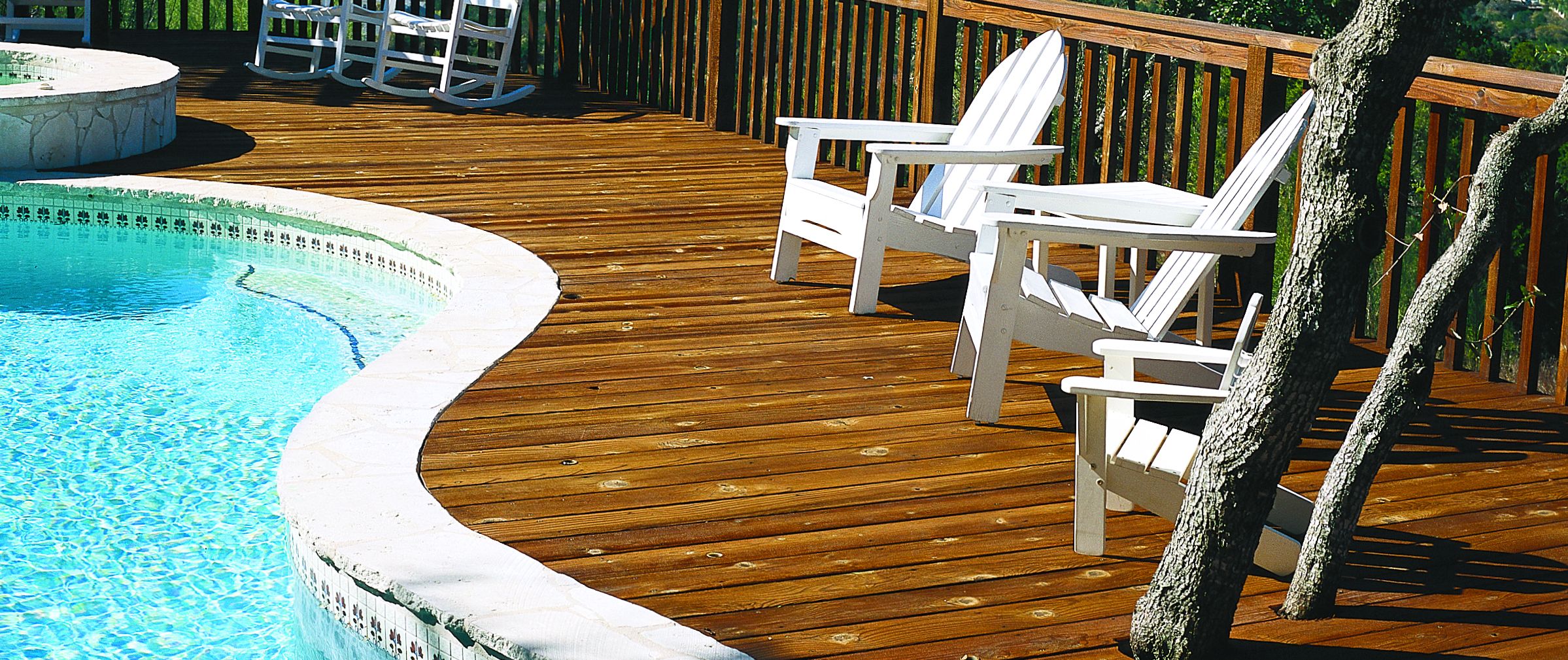We may be compensated if you purchase through links on our website. Our team is committed to delivering honest, objective, and independent reviews on home products and services.
Revitalizing a weathered deck can transform your outdoor living space, making it look as good as new. The keys are simple: Use the right cleaners, work methodically, and go easy with the power washer to avoid damaging the wood. “You’ll be surprised at how easily and effectively a homeowner can accomplish [the project]” says Erich Specht, a professional refinisher from Austin, Texas.
Below, Specht shares his techniques for bringing an old deck back to life.
Day 1: Cleaning and Bleaching
Before cleaning, gather some equipment and materials:
- Boots and PVC-coated rain pants for protection
- Non-chlorine bleach, such as OxiClean (hydrogen peroxide and sodium carbonate)
- 3,000 psi power washer with a 40-degree fan tip
- 2-gallon pump sprayer with a fan tip
- TSP (trisodium phosphate) or a TSP substitute
- Wood brightener (oxalic acid) for cedar or redwood decks only
Start by replacing any cracked or damaged boards with the same species of wood, securing them with stainless steel decking screws. Match the wood species to maintain the deck’s consistency and durability. Trim nearby foliage and thoroughly wet down surrounding plants to protect them from cleaning solutions.
Power Washing Precautions
Power washers save time and water, but the high-pressure stream can gouge wood, break glass, and cut through skin in an instant. We recommend following these safety guidelines:
- Protect your legs and feet with boots, and never point the wand at yourself or anyone else.
- Take a test run on your driveway to get comfortable operating the machine.
- Take time to get used to the machine, and use only the 40-degree fan tip.
- If your power washer has adjustable pressure, set it to 3,000 psi. This is the level recommended for 40-degree fan tips. A lower setting will work, but the job will take longer. Higher settings are more likely to cause damage.
If you’re uncomfortable using a power washer, a stiff-bristle scrub brush can achieve similar results, but it’ll take more time and effort. Both techniques are effective in removing dirt and mildew, but manual scrubbing might require additional elbow grease.

Step 1: Clean
Begin by wetting the wood with water from a hose or power washer, holding the tip at least 18 inches from the surface. This helps distribute the cleaning solution evenly. Mix the deck cleaner according to the manufacturer’s instructions and apply it to the wet wood using a pump sprayer. Allow the cleaner to work for about 10 minutes before moving on to the next step.

Step 2: Wash
Hold the spray fan perpendicular to the gaps between the boards and power wash mildew and dirt from the wood using long, smooth, overlapping strokes. To prevent gouging, maintain a distance of 4–6 inches from the surface, keep the wand moving continuously, and lift the tip at the end of each stroke.
When washing railings and balusters, hold the tip 3–5 inches away and aim at the corners to clean two sides simultaneously.

Step 3: Rinse
Working from the railings down, use the power washer to remove any loosened grime and wood pulp. Hold the tip at least 18 inches from the wood surface, aligning the fan with the gaps in the deck to dislodge any debris between the boards. Rinse two or three times for thorough cleaning.
We recommend wetting nearby foliage again to protect it from the bleach used in the next step. The repeated rinsing reduces the chance of leaving behind residue that could interfere with your finish.
Day 2: Applying the Finish
Allow your deck to dry for at least three consecutive rain-free days before applying the finish. When it’s ready for the finish, choose a day with no chance of rain and little wind.
You’ll need the following materials:
- 2-gallon pump sprayer with a fan tip
- Foam applicator pad with extension pole
- Sufficient finish to cover decking and railings
To prevent overspray, protect surrounding plants, grass, and structures with plastic sheets or tarps. You’ll need to use a different sprayer from the one used for cleaning and bleaching. For consistent color, mix all the finish in a bucket before spraying.
Types of Deck Finishes
Deck finishes come in three main varieties, each with its own benefits:
- Clear sealer: A pigment-free finish that allows the wood’s natural color to show through, but offers minimal UV protection.
- Semitransparent stains: A middle-ground option that provides good UV protection while letting some of the wood’s natural grain show through.
- Solid stains: A full-coverage, high-pigment option that offers excellent UV protection but hides the wood’s grain.
If you choose a semitransparent stain, remember that its appearance can vary depending on the type of wood. To guarantee that you’ll be happy with your choice, test a small sample on a piece of scrap decking and let it sit outdoors for a few days. Looking at the sample in different lighting conditions can help you see how the finish will look in various scenarios.
Applying the Finish
Follow these steps for the best results:
- Start by applying the finish to the railings and balusters, working from top to bottom. This will help prevent drips and runs on the decking.
- Use the pump sprayer to apply the finish to the decking, working in small sections. This helps with even application and allows you to control the amount of finish you lay down.
- Immediately after spraying, use the foam applicator pad to work the finish into the wood grain for even coverage. The applicator pad helps distribute the finish evenly and reaches into the wood grain, enhancing its protective qualities.
- Allow the finish to dry completely before using the deck, following the manufacturer’s recommended drying time. Proper drying time prevents damage and extends the longevity of the finish.
Depending on your climate, level of sun exposure, and the type of finish used, a newly refinished deck can maintain its appearance for between two and four years before requiring another treatment. Regular maintenance, such as sweeping off leaves and hosing down pollen and dirt, will help extend the life of your deck’s new finish.
Where To Find It
Non-chlorine bleach: OxiClean
Semitransparent sealer: TWP (Total Wood Protection) Stains
Clear sealer: Thompson’s WaterSeal
Semitransparent deck stain: Wolman by Rustoleum
Solid-color deck stain: Cabot Stain

